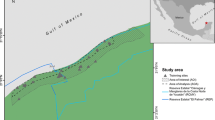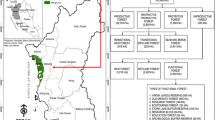Abstract
Amongst the most threatened ecosystems on Earth, mangrove forests are also one of the more difficult to work in due to their growth in mud and open water coastal zones and their dense tangled stems, branches and prop roots. Consequently, there has been an impetus to employ remotely sensed imagery as a means for rapid inventory of these coastal wetlands. To date, the majority of mangrove maps derived from satellite imagery utilize a simple mangrove classification scheme which does not distinguish mangrove species and may not be useful for conservation and management purposes. Although more elaborate satellite based mangrove classification schemes are being developed, given their enhanced complexity they deserve additional justification for end users. The purpose of this study was to statistically examine the appropriateness of one such classification scheme based on an inventory of field data. In January of 2007 and May of 2008, 61 field sample plots were selected in a stratified random fashion based on a previous classification of a degraded mangrove forest of the Isla La Palma (Sinaloa, Mexico) using Landsat TM5 data. Unlike other previous Landsat TM based classifications of this region, which simply identified the mangrove forests as one class, the mangroves were classified (i.e. mapped) according to four conditions; healthy tall, healthy dwarf, poor condition, and dead mangroves. Within each sample plot, all mangroves of diameter of breast height (dbh) greater than 2.5 cm were identified and their height, condition and dbh recorded. An estimated Leaf Area Index (LAI) value also was obtained for each sample and the shortest distance from the center of each sample plot to open flowing water was determined using a geographic information system (GIS) overlay procedure. These data were then used to calculate mean values for the four classes as well as to determine stem densities, basal areas, and the Shannon–Wiener diversity index. In order to assess the appropriateness of this mangrove classification scheme a discriminant analysis approach was then applied to these field data. The results indicate this forest has undergone severe degradation, with decreasing mean tree heights, mean dbh and species diversity. In regards to the discriminant analysis procedure, further classification of these field plots and cross-validation based on these significant variables provided high classification accuracy thus validating the appropriateness of the satellite based image classification scheme. Moreover, the discriminant analysis indicated that the estimated LAI, mean height, and mean dbh are significant in the separation of the classification of mangrove forest condition along these field sample plots.



Similar content being viewed by others
References
Allen J, Ewel AK, Jack J (2001) Patterns of natural and anthropogenic disturbance of the mangroves on the Pacific Island of Kosrae. Wetlands Ecol Manage 9:279–289
Ball MC (1998) Mangrove species richness in relation to salinity and waterlogging: a case study along the Adelaide River floodplain, Northern Australia. Glob Ecol Biogeogr Lett 7:73–82
Barbier EB, Sathirathai S (2004) Shrimp farming and mangrove loss in Thailand. Edward Elgar, London
Basak UC, Das AB, Das P (1996) Chlorophylls, carotenoids, proteins and secondary metabolites in leaves of 14 species of mangroves. Bull Marine Sci 58:654–659
Berlanga-Robles CA, Ruiz-Luna A (2002) Land use mapping and change detection in the coastal zone of Northwest Mexico using remote sensing techniques. J Coastal Res 18:514–522
Cole TG, Ewel KC, Devoe NN (1999) Structure of mangrove trees and forests in Micronesia. Forest Ecol Manage 117:95–109
Duke NC, Meynecke JO, Dittmann S, Ellison AM, Anger K, Berger U, Cannicci S, Diele K, Ewel KC, Field CD, Koedam N, Lee SY, Marchand C, Nordhaus I, Dahdouh-Guebas F (2007) A world without mangroves? Science 317:41–42
Green EP, Clark CD, Mumby PJ, Edwards AJ, Ellis AC (1998) Remote sensing techniques for mangrove mapping. Int J Remote Sens 19:935–956
Everitt JH, Yang C, Judd FW (2010) Use of archive aerial photography for monitoring black mangrove populations. J Coastal Res 26:649–653
Ewel KC, Twilley RR, Ong JE (1998) Different kinds of mangrove forests provide different goods and services. Glob Ecol Biogeogr Lett 7:83–94
Flores-Verdugo FJ, Gonzáles-Farías F, Blanco-Correa M, Nuñez-Pastén A (1997) The Teacapan-Agua Brava-Marismas Nacionales mangrove ecosystem on the Pacific coast of Mexico. In: Kjerve B, Drude de Lacerda L, Diop EHS (eds) Mangrove ecosystem studies in Latin America and Africa. UNESCO,ISME & US Forest Service, US, pp 35–46
Fuente G, Carrera E (2005) Cambio de uso del suelo en la zona costera del Estado de Sinaloa. Final report to United States Forest Service. Grant no. 03-DG-11132762-157, Mexico: Ducks Unlimited de Mexico, AC, Garza Garcia, NL
Held A, Ticehurst C, Lymburner L, Williams N (2003) High resolution mapping of tropical mangrove ecosystems using hyperspectral and radar remote sensing. Int J Remote Sens 24:2739–2759
Hirano A, Madden M, Welch R (2003) Hyperspectral image data for mapping wetland vegetation. Wetlands 23:436–448
Hogarth PJ (1999) The biology of mangroves. Oxford University Press, Oxford
Kovacs JM (1999) Assessing mangrove use at the local scale. Landscape Urban Plan 43:201–208
Kovacs JM (2000) Perceptions of environmental change in a tropical coastal wetland. Land Degrad Dev 11:209–220
Kovacs JM, Wang J, Blanco-Correa M (2001) Mapping mangrove disturbances using multi-date Landsat TM imagery. Environ Manage 27:763–776
Kovacs JM, Flores-Verdugo F, Wang J, Aspden LP (2004) Estimating leaf area index of a degraded mangrove forest using high spatial resolution satellite imagery. Aquat Bot 80:13–22
Kovacs JM, Wang J, Flores-Verdugo F (2005) Mapping mangrove leaf area index at the species level using IKONOS and LAI-2000 sensors for the Agua Brava Lagoon, Mexican Pacific. Estuarine Coastal Shelf Sci 62:377–384
Kovacs JM, Vandenberg CV, Flores-Verdugo F (2006) Assessing fine beam RADARSAT-1 backscatter from a white mangrove (Laguncularia racemosa (Gaertner)) canopy. Wetlands Ecol Manage 14:401–408
Kovacs JM, Vandenberg CV, Wang J, Flores-Verdugo F (2008a) The use of multipolarized spaceborne SAR backscatter for monitoring the health of a degraded mangrove forest. J Coastal Res 24:248–254
Kovacs JM, Zhang C, Flores-Verdugo F (2008b) Mapping coastal wetland using C-band ENVISAT ASAR and landsat optical data. Cienc Marinas 34:407–418
Kovacs JM, King JML, Flores de Santiago F, Flores-Verdugo F (2009) Evaluating the condition of a mangrove forest of the Mexican Pacific based on an estimated leaf area index mapping approach. Environ Monit Assess 157:137–149
Krause G, Bock M, Weiers S, Braun G (2004) Mapping land-cover and mangrove structures with remote sensing techniques— a contribution to a synoptic GIS in support of coastal management in North Brazil. Environ Manage 34:429–440
Krebs C (1989) Ecological methodology. HarperCollins, New York
Linneweber V, de Lacerda LD (2002) Mangrove ecosystems: function and management. Springer, Berlin
Long BG, Skews TD (1996) A technique for mapping mangroves with Landsat TM satellite data and geographic information system. Estuarine Coastal Shelf Sci 43:373–381
Lucas RM, Mitchell AL, Rosenqvist A, Proisy C, Melius A, Ticehurst C (2007) The potential of L-band SAR for quantifying mangrove characteristics and change: case studies from the tropics. Aquat Conserv 17:245–264
Madden M, Jones D, Vilcheck L (1999) Photointerpretation key for the everglades vegetation classification system. Photogramm Eng Remote Sens 65:171–177
McDonald KO, Webber DF, Webber MK (2003) Mangrove forest structure under varying environmental conditions. Bull Marine Sci 73:491–505
Mitsch WJ, Gosselink JG (2007) Wetlands. Wiley, New York
Rakotomavo A, Fromard F (2010) Dynamics of mangrove forests in the Mangoky River delta, Madagascar, under the influence of natural and human factors. Forest Ecol Manage 259:1161–1169
Saito H, Bellan MF, Al-Habshi A, Aizpuru M, Blasco F (2003) Mangrove research and coastal ecosystem studies with SPOT-4 HRVIR and TERRA ASTER in the Arabian Gulf. Int J Remote Sens 24:4073–7092
Salovaara KJ, Thessler S, Malik RN, Tuomisto H (2005) Classification of amazonian primary rain forest vegetation using Landsat ETM+ satellite imagery. Remote Sens Environ 97:39–51
Simard M, De Grandi G, Saatchi S, Mayaux P (2002) Mapping tropical coastal vegetation using JERS-1 and ERS-1 radar data with a decision tree classifier. Int J Remote Sens 23:1461–1474
Tong PHS, Auda Y, Populus J, Aizpuru M, Blasco F (2004) Assessment from space of mangrove evolution in the Mekong Delta, in relation to extensive shrimp farming. Int J Remote Sens 25:4795–4812
Vaiphasa C, Ongsomwang S, Vaiphasa T, Skidmore AK (2005) Tropical mangrove species discrimination using hyperspectral data: a laboratory study. Estuarine Coastal Shelf Sci 65:371–379
Valiela I, Boen JL, York JK (2001) Mangrove forests: one of the world’s threatened major tropical environments. Bioscience 51:807–815
Walters BB, Ronnback P, Kovacs JM, Crona B, Hussain SA, Badola R, Primavera JH, Barbier E, Dahdouh-Guebas F (2008) Ethnobiology, socio-economics and management of mangrove forests: a review. Aqua Bot 89:220–236
Wang L, Sousa W (2009) Distinguishing mangrove species with laboratory measurements of hyperspectral leaf reflectance. Int J Remote Sens 30:1267–1281
Wang L, Sousa WP, Gong P, Biging GS (2004) Comparison of IKONOS and QuickBird images for mapping mangrove species on the Caribbean coast of Panama. Remote Sens Environ 91:432–440
Wang L, Silvan J, Sousa W (2008) Neural network classification of mangrove species from multiseasonal IKONOS imagery. Photogramm Eng Remote Sens 74:921–927
Welch RW, Madden M, Doren R (1999) Mapping the everglades. Photogramm Eng Remote Sens 65:163–170
Wilkie ML, Fortuna S (2003) Status and trends in mangrove area extent worldwide. http://www.fao.org/docrep/007/j1533e/j1533e00.htm. Accessed 20 april 2009
Xue C (1996) Coastal sedimentation, erosion and management of Kosrae, Federated States of Micronesia. SOPAC Technical Report 228, South Pacific Geoscience Commission, Suva, Fiji
Yu B, Ostland IM, Gong P, Pu RL (1999) Penalized discriminant analysis of in situ hyperspectral data for conifer specie recognition. IEEE Trans Geosci Remote Sens 5:2569–3577
Acknowledgments
This study was funded by a Natural Sciences and Engineering Research Council of Canada grant (No. #249496-06) awarded to John M. Kovacs. The authors would like to acknowledge the assistance of Lance P. Aspden and Joshua M.L. King for their assistance in the field data collection campaigns of 2007 and 2008, respectively. We appreciate the comments from the anonymous reviewers which helped improve the quality of this paper.
Author information
Authors and Affiliations
Corresponding author
Rights and permissions
About this article
Cite this article
Kovacs, J.M., Liu, Y., Zhang, C. et al. A field based statistical approach for validating a remotely sensed mangrove forest classification scheme. Wetlands Ecol Manage 19, 409–421 (2011). https://doi.org/10.1007/s11273-011-9225-3
Received:
Accepted:
Published:
Issue Date:
DOI: https://doi.org/10.1007/s11273-011-9225-3




